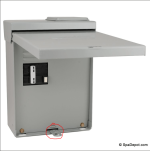phonedave
Well-known member
- May 30, 2012
- 1,972
- Pool Size
- 17000
- Surface
- Vinyl
- Chlorine
- Salt Water Generator
- SWG Type
- Hayward Turbo Cell (T-CELL-5)
Absolutely! Some disconnects are truly that, a device that completes the circuit can be removed. They are put in my pocket until I'm done. Can never forget to put it back because the repair has to be tested, so in it goes. The combo disconnect/GFCI boxes all have a hole in the catch. I will either use a small combination lock, or if I can't find that, a zip tie. Its up to me, and any worker, to provide our own safety.
Yes, most of the time there is a way to prevent accidental energization of the circuit, but since the code does not require it, it is technically up to code not to have a way to prevent it.
Lock Out / Tag Out is a big thing in telecommunications plant too, especially in the COs, but it used to be in the field as well, especially in the days of pulp cable and breakdown sets.



